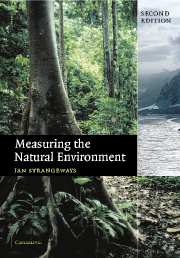Book contents
- Frontmatter
- Contents
- Acknowledgements
- 1 Basics
- 2 Radiation
- 3 Temperature
- 4 Humidity
- 5 Wind
- 6 Barometric pressure
- 7 Evaporation
- 8 Precipitation
- 9 Soil moisture and groundwater
- 10 Rivers and lakes
- 11 Data logging
- 12 Telemetry
- 13 Visibility
- 14 Clouds
- 15 Lightning
- 16 The upper atmosphere
- 17 The oceans
- 18 Cold regions
- 19 Remote sensing
- 20 Atmospheric composition
- 21 Forward look
- Appendix: abbreviations and acronyms
- Index
- References
18 - Cold regions
Published online by Cambridge University Press: 05 July 2014
- Frontmatter
- Contents
- Acknowledgements
- 1 Basics
- 2 Radiation
- 3 Temperature
- 4 Humidity
- 5 Wind
- 6 Barometric pressure
- 7 Evaporation
- 8 Precipitation
- 9 Soil moisture and groundwater
- 10 Rivers and lakes
- 11 Data logging
- 12 Telemetry
- 13 Visibility
- 14 Clouds
- 15 Lightning
- 16 The upper atmosphere
- 17 The oceans
- 18 Cold regions
- 19 Remote sensing
- 20 Atmospheric composition
- 21 Forward look
- Appendix: abbreviations and acronyms
- Index
- References
Summary
And now there came both mist and snow,
And it grew wondrous cold:
And ice, mast-high, came floating by,
As green as emerald.
And through the drifts the snowy clifts
Did send a dismal sheen:
Nor shapes of men nor beasts we ken —
The ice was all between.
The ice was here, the ice was there,
The ice was all around:
It crack'd and growl'd and roar'd and howl'd
Like noises in a swound!
Samuel Taylor Coleridge The Rime of the Ancient Mariner.Just as the oceans cover a large fraction of the Earth's surface, so too do the cold regions, and they are even more poorly monitored. In the past, the main reason for little data being collected here was simply that few people lived in these regions or travelled to them, data coming in the last 150 years mostly from the occasional expedition to Antarctica or from a special laboratory such as on Ben Nevis in Scotland. But modern automatic instrument systems do not require frequent attention and it is now possible to site them anywhere. The main difficulty now in cold regions is not the need for operators but the problems of the environment itself.
Observation problems at low temperatures
Low temperature in itself is not a major problem for instruments. Electronic and mechanical components can operate in temperatures down to —40 °C or lower, and batteries continue to function at these extremes, although perhaps with a reduced capacity. The main problems arise from the effects of snow and ice adhering to (or filling) the sensors, often accompanied by strong winds. The question considered here is how to protect sensors from their damaging and disabling effects.
- Type
- Chapter
- Information
- Measuring the Natural Environment , pp. 452 - 468Publisher: Cambridge University PressPrint publication year: 2003



